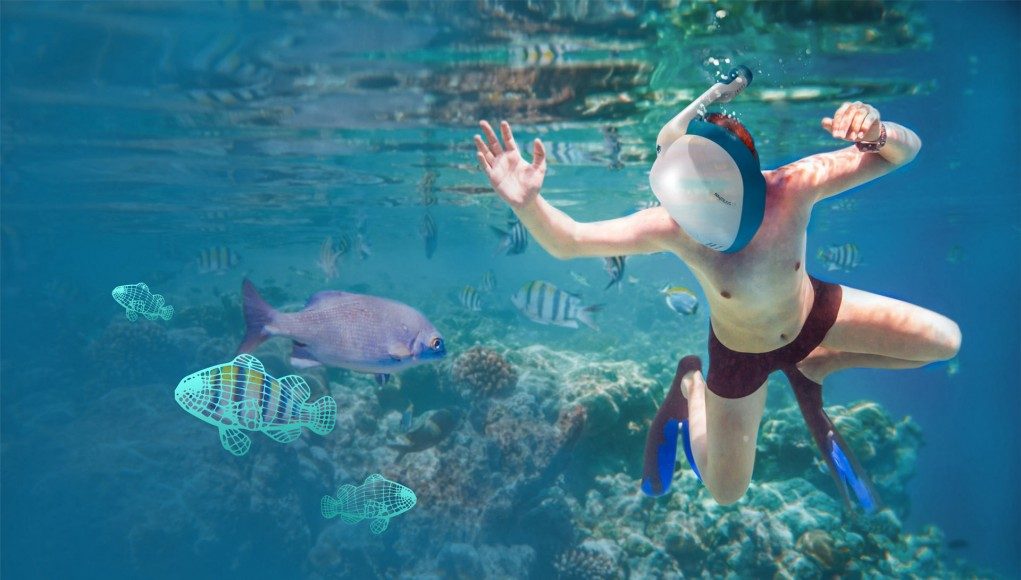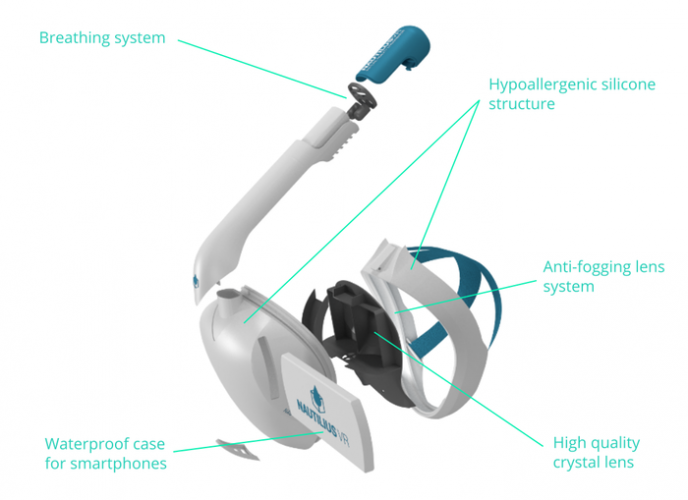‘Project Nautilus VR’, a now cancelled Kickstarter campaign featuring an app and VR headset combo, wanted to take underwater VR experiences for Google Cardboard one step further: by actually putting you and your beloved smartphone head-first into a pool. And the thing is, it wasn’t even cancelled because of how horrifying all of that sounds.
Remotte LLC launched its Kickstarter campaign with the hopes that their smartphone-driven VR headset, ‘Project Nautilus VR’, would be a “truly immersive underwater virtual reality headset for everyone.” Underwater augmented reality, alla Microsoft’s latest ‘Productivity Future’ video, I have no problem getting behind. But underwater virtual reality?
Project Nautilus VR on Kickstarter
Like Google Cardboard, the Project Nautilus VR headset was designed to obscure the entire visual field of the user, and replace it with the screen of smartphone. Boasting a 90 degree FOV for a variety of smartphones sizes, the company’s goal was to let you swim around with the snorkeled VR headset using their proprietary educational app and presumably any other Cardboard-compatible experience like Pocket Dolphins or Dive Deep.
However in an update to their campaign on Saturday, the company announced the project’s cancellation, citing “a potential delivery delay of one the basic material” and also that they “prefer to make sure [they] will be able to deliver the Nautilus on due time.” Remotte says that the project will eventually be relaunched under the guise they get “more information about a definitive production and delivery delay.”
Water, Water Everywhere
Putting any personal phobias aside about being blinded in a pool, a place that admittedly requires a lot more situational awareness than your office spinny-chair—there are a few outstanding practical issues at the heart of the project that may be to blame for its slow start and subsequent cancellation.
The lack of positional tracking and peripheral input inherent to these smartphone VR adapters would mean that you’d be stuck in one fixed position within the virtual space while your physical body floated around unabated—which is fine for submersion, but not so helpful for immersion. Premium access to their proprietary app was also planned to be offered via a yearly subscription fee of $9.99, a cost that the campaign graciously waved for all backers of the project. And the savings didn’t stop there either, backers were offered to nab the super early bird special of $49, though the bizarre-looking aquatic headset was estimated to retail at a whopping $199.99.
The campaign also seemed to conveniently gloss over one of the most important reasons smartphone holders like Google Cardboard are so effective: the low cost and cheap building materials set your expectations of the interaction.
With Cardboard headsets as cheap as $2 with free shipping from China, these VR smartphone holders can’t ‘wow’ you with their super immersive scenes, simply because the guts inside alone can’t provide it at any cost. While smartphone-based VR can provide some visually compelling content for short encounters, the sensors in current smartphones just aren’t up to the job of doing anything more ambitious, and are notoriously susceptible to latency and drift—a phenomenon when the device can’t accurately track your head movements, and you end up looking in a different direction than you started at. This is partly why Samsung Gear VR has its own on-board IMU, and although not perfect, is much more sensitive then the stock IMU on its companion smartphone, the Galaxy Note 4.
That said, if you’re still looking to get in the pool and mess around with your smartphone while waiting for Project Nautilus to rekick their Kickstarter, there’s at least one DIY solution out there. Assistant Professor John Quarles of the University of Texas Dept of Computer Science has constructed a 3D printed holder for his aquatic rehabilitation app Shark Punch, that puts you in a fight with a bothersome shark and teaches you to be assertive with the underwater menace.
As for this land lubber, I’ll be back in my safe (and dry) spinny-chair.








